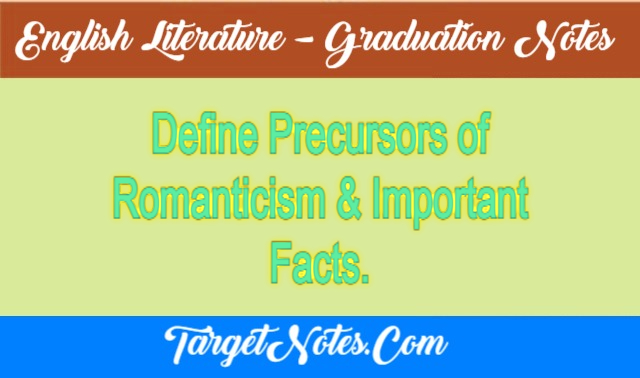
Define Precursors of Romanticism & Important Facts.
Contents
Precursors of Romanticism & Important Facts
A Brief Introduction
Romanticism or romantic revival is derived from the word romance which means something imaginative, adventures, thrilling and wonderful. The Romanticism or the Romantic movement, often called the second Renaissance, was both a revolt and revial. In this way, we can say that it was a revolt against the hard tempers, the dry intellectuality and artificiality which were the chief characteristics of the ‘neo classical’ poetry. Couper, Gabbe, Collins, Blake, Burns and Gray are recognized as the precursors of the Romantic movement. The term that best fits these varying features in the term Romance; it expresses the great writers of the time.
Important Facts to Remember
1. Firstly, William Wordsworth is universally recognized as the high priest of Nature’. He himself proclaimed that he was a worshipper of nature’. Love of nature was in his blood. His greatest contribution to nature poetry is that he gave a soul of nature.
2. Wordsworth said, “We are laid asleep in body and became a living soul.” At that time nature to him was “call in all.”
3. The Second Stage was a period of sensuous love of nature. Like Keats, Wordsworth loved the sensuous beauties of nature. Keats said, “O’for a life of sensation rather than of thought.” That is to say, “He did not have any interest beyond sensuous pleasure.”
4. In Third Stage, Wordsworth writes in “Tintern Abby that time is past.” Wordsworth perception of nature is growing deeper and deeper. From the the Physical of sensuous. From sensuous to the intellectual. And now from intellectual to the spiritual. This is the nature development of his nature.
5. The first three stages were transitory. The spiritual stage was lasting. Like a mystic Wordsworth deeper and deeper into this stage. Wordsworth said, “All thinking things, all object of all thoughts, And rolls through all thing.”
6. The traits of Romanticism were found in the writers of transition like Gray and Collins. Between the poets of transition and romantic poets, there were poets like William Cowper, George Gabbe, Robert Burns and William Blake who herald the down of the Romantic revival. They were precursors of romanticism.
7. William Cowper wrote poems like The Task’, The Winter Walk’, ‘On The Receipt of My Mother’s Picture’. George Crabbe’s important works are The Library, The Village’.
8. Robert Burns reaped the benefit of the literary traditions of his country. He published ‘poems’ in 1786.
9. William Blake wrote poetry of ordinary things. His Poetical Sketches’, ‘Song of Innocence’ and ‘Songs of Experience’ express his love of the country, of simple life and of childhood and home.
Related Link
- Features of Developed Money Market | Recent developments in India’s money market
- Main Forms of Government Securities
- Instruments of Issue
- Difference between capital market and money market
- Role of SEBI in Regulating the Capital Market
- Functions of SEBI: Regulatory and Preventive Functions
- Advantages and Disadvantages of call money market
- Recent trends in the Indian capital market
- Characteristics of Indian Capital Market
- Globalisation and Indian Financial Market
IMPORTANT LINK
- What is the Exchange Rate System in India?
- Evolution of foreign exchange market in India
- Meaning and importance of export finance.
- Role of Export-Import Bank in Financing India’s Foreign Trade
- How Commercial banks Export Finance to Overseas Importers?
- Explain packing credit in detail?
- What is Post-shipment credit?
- What is Pre-shipment or packing credit?
- Explain Export Credit in India?
- Institutions Providing Finance and Credit Facility for Foreign Trade
- What is Risk Analysis?
- Explain Political risks in detail? and its Types
- What are the types of Risks. Explain in detail?
- Meaning and Types of commercial risks
- How can we minimize foreign trade risks?
- What are Arbitrage operations?
- Difference between Spot Market and Forward Market
- What is spot exchange?
- Agency agreement: Meaning, Features and Advantages
- Functions of Foreign Exchange markets
- structure of Foreign exchange markets
- Describe the various types of money
- Dynamic Functions of Money
- Evils or Demerits of Money
- Importance and significance of money in Modern Economy
- Approaches regarding Definitions of Money and its Function
- Money: Meaning, Definitions and features of Money
Disclaimer






